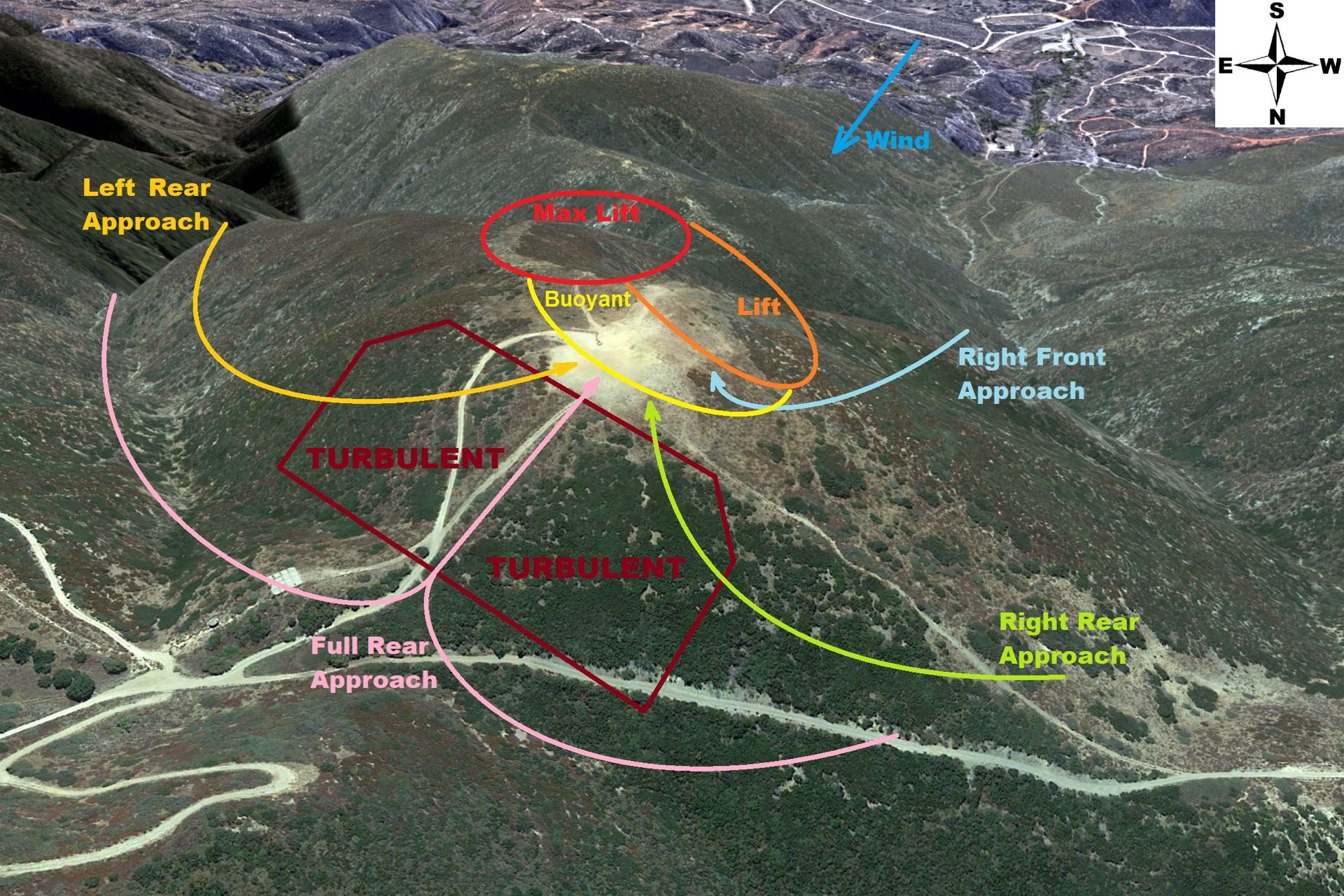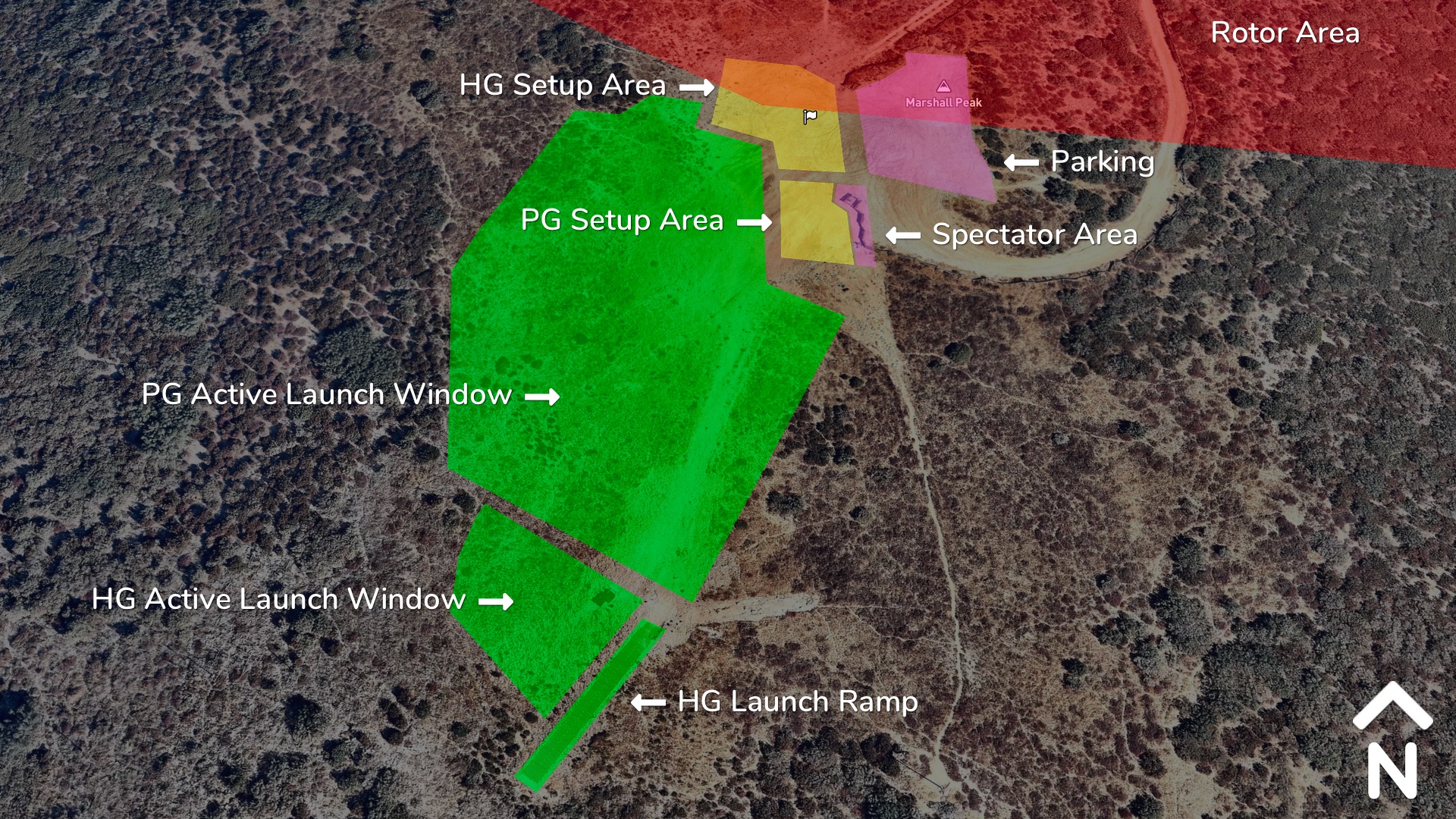Overview
Marshall Peak launch (or simply “Marshall”) is a very large, flat slope launch in the San Bernardino Mountains. It sits at approximately 4000′ MSL, has ample parking and setup areas, and separate launch areas for hang gliders and paragliders. Hang gliders can be either foot-launched, or launched on wheels via the wooden runway at the bottom of the launch area. There are no restrooms or additional facilities at this launch.
Pilots must familiarize themselves with this information before arriving, and this information DOES NOT replace the need for an in-person site briefing from a local pilot or instructor familiar with the area.
Visiting Pilots: All launches and LZs require a P3/H3 rating or above. Visitors NOT meeting P3/H3 requirements must schedule instruction or observation with a local instructor before arriving.
- Minimum ratings: Intermediate (P3/H3). Read the General Site Guidelines for exceptions.
- GPS Coordinates: 34.21, -117.3029. View Map.
- Type: Flat Slope Launch.
- Altitude: 3973′ MSL.
- Orientation: SW, SSW.
- Best conditions: Light S winds (0-10 mph for PG, 0-15 for HG). SE to W winds are acceptable. Launching is not advised if greater than 5 mph N winds at Crestline launch.
- Glide ratio to AJX: 3.7:1.
- Vehicle access: Dirt road (2WD vehicles with moderate clearance OK).
Details
Local Conditions & Hazards
High Wind and Gusty Wind Conditions
The Marshall Launch can be susceptible to gusty winds and high winds. Pilots are advised to consider their launching technique and experience before launching in these conditions and to use a wire-man. HG pilots are encouraged to obtain launch assistance during periods of high winds or gust spreads. Simply being able to launch does not imply that “the worst is over,” as the thermic air may be rougher than the pilot wants to manage. More information on when rough air can be expected is available here.
The Caution Zone
In front of the launch’s flat slope where air coming up at a more vertical angle mixes with the general winds, one should expect turbulence.
Venturi Area
One should expect venturi immediately west of launch.
Additional Launch Hazards & Obstacles
- Marshall is a key thermal generator and can see extreme mid-day thermic conditions. There have been instances of gliders getting turned back into the hill and paraglider collapses close to the terrain.
- Hang Glider pilots are strongly encouraged to walk down to the lower launch next to the windsock.
- Top landings are not recommended during mid-day thermic conditions.
- Pilots intending to top land should yell down to those on the ground to make their intent clear.
- Wildlife danger – snakes, mountain lions, bears.
- Thunderstorms can develop, particularly in the spring and fall which can lead to gust fronts. Be on the lookout for a “wall of dust” (See figure 2 and 3) on days with towering cumulus.
House Thermal
The house thermal can be found at the top of the spine just to the pilot’s left after launching. Do not explore the area east of the house thermal spine, unless with sufficient altitude to come back while facing a headwind.
Setup & Launching
Setup
Marshall is a very large launch, with plenty of room to set up both hang gliders and paragliders. Please do not unpack/connect your wing in the launch area – do this instead behind as to not hold up others which already have their gear connected and ready.
Unattended Gliders in the Setup Area
The setup area at Marshall is exposed to the wind and very susceptible to thermal activity. Hang glider pilots are encouraged to tie down their glider or remain with their glider at all times.
Launching
Marshall is a fairly flat slope launch – expect touch and go’s while launching. Paragliders should consider progressively adding some braking if they think they may touch the ground again and re-run. A good time to launch is when one feels desirable wind where they are on launch AND the windsock at the front of launch shows desirable wind as well (as that wind will arrive in a few seconds).
If ridge soaring in front of launch at launch height, keep in mind that you may be blocking pilots waiting to launch. Please be aware of pilots on launch that are either preparing to launch or actively launching, both to prevent holding up launch traffic and to be aware of others joining the air traffic.
Hang Glider Top Launch
Experienced, local pilots often launch from the top of Marshall just North-West of the paraglider launch. When the wind conditions are right, this top launch is a viable option. However, the top launch is a shallow slope launch and very susceptible to wind shadow. The wind shadow often sets up towards the end of the launch when a pilot expects their wing to start flying. Pilots must be proficient with shallow slope launches and understand how to read and access wind shadow before attempting to top launch at Marshall.
Top Landing
It is possible to top land at Marshall and local pilots often land paragliders and lower performance hang gliders on the top of Marshall. Before attempting to top land, pilots must be aware of the winds and thermals that cycle across Marshall peak and they must be aware of spectators and gliders that are on the ground. Pilots need to have the skills to assess out-landings with varying wind conditions and have the skills to define and follow an approach while flying before attempting to top land at Marshall.
Approaches
All top landing approaches have risks. In the following diagram, the “right rear” approach is the best compromise for most pilots, as the least amount of time is spent in the turbulent area behind launch. It is helpful to turn into the wind at the end of the final approach. The “right front” approach is an option for pilots capable of timing a landing turn (which has its risks). Timing is critical for this approach, as pilots need to execute a sharp turn into the wind during the final approach, which increases sink. If sunk on final approach: close call with terrain. The “left rear” and “full rear” approaches are to be avoided.

Keep in mind: Top landings are optional, do not feel obliged to do it to look cool or to facilitate a vehicle recovery. Many pilots (some with high experience) have been injured from a top landing. Highest risk is when conditions are thermic. Best time to practice is 1 hour before sunset (when conditions are mostly smooth) and start with trial passes having extra altitude.
More details about top landing on Marshall can be found here.
Driving Directions
Please drive slowly on 2N40 (the dirt road to launch)! There are several blind corners and there have been head-on collisions.
directions TBD.
Parking
All vehicles should park on the east side of the upper setup area. At the end of the dirt road, you will notice railroad ties, forcing you to make a 90° turn to the right. The parking area is to your right after this turn. Parking in areas other than the designated parking area to the east can block setup operations and pilots attempting top landings.
Spectators & Pets
Spectators are welcome at Marshall but they are not as common as they are at Crestline. Still, pilots need to be aware of spectators and avoid launching when spectators are below the HG or PG launches.
If you see a spectator vehicle parked at the west end of the launch, please ask that they move their vehicle to the designated parking area to allow for top landings.
Since spectators may not be aware of the dangers present on launch, if you see spectators with pets, please ask that they keep them on a leash as pets may interfere with launch operations and introduce unnecessary risks for pilots.
Citations: Launch, top landing, and site condition information supplied by Jérôme Daoust. Further information available on his website here.
Last Revised: March 11, 2021
Additional Info
- Site Frequency: 145.555
- Other Frequencies: Read more here
- Emergencies: Follow the instructions and information available in the CSS Emergency Action Plan.
- Rides: Need a ride to launch?
